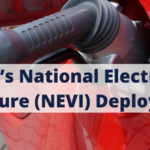The State of New Jersey has committed to the widespread deployment of Electric Vehicle (EV) charging technologies in the pursuit of cleaner, less carbon intensive roadway travel. With the establishment of the National Electric Vehicle Infrastructure program (NEVI) in the Bipartisan Infrastructure Law (BiL), also known as the Infrastructure Investment and Jobs Act (IIJA), additional federal funding will be available to support New Jersey’s EV transition ambitions.
To receive NEVI Formula Program funds, states are required to develop an FHWA-approved EV Infrastructure Deployment Plan that describes how the state intends to use the funds in accordance with the NEVI Formula Program Guidance. The State of New Jersey convened a multi-agency task force that included the New Jersey Department of Transportation (NJDOT), NJ Department of Environmental Protection (NJDEP), NJ Board of Public Utilities (NJBPU), the NJ Economic Development Authority (NJEDA), among others (1), to meet the August 1, 2022 deadline for plan submission to the Joint Office of Energy and Transportation with FHWA approval expected by September 30, 2022.
Funding for EV Chargers
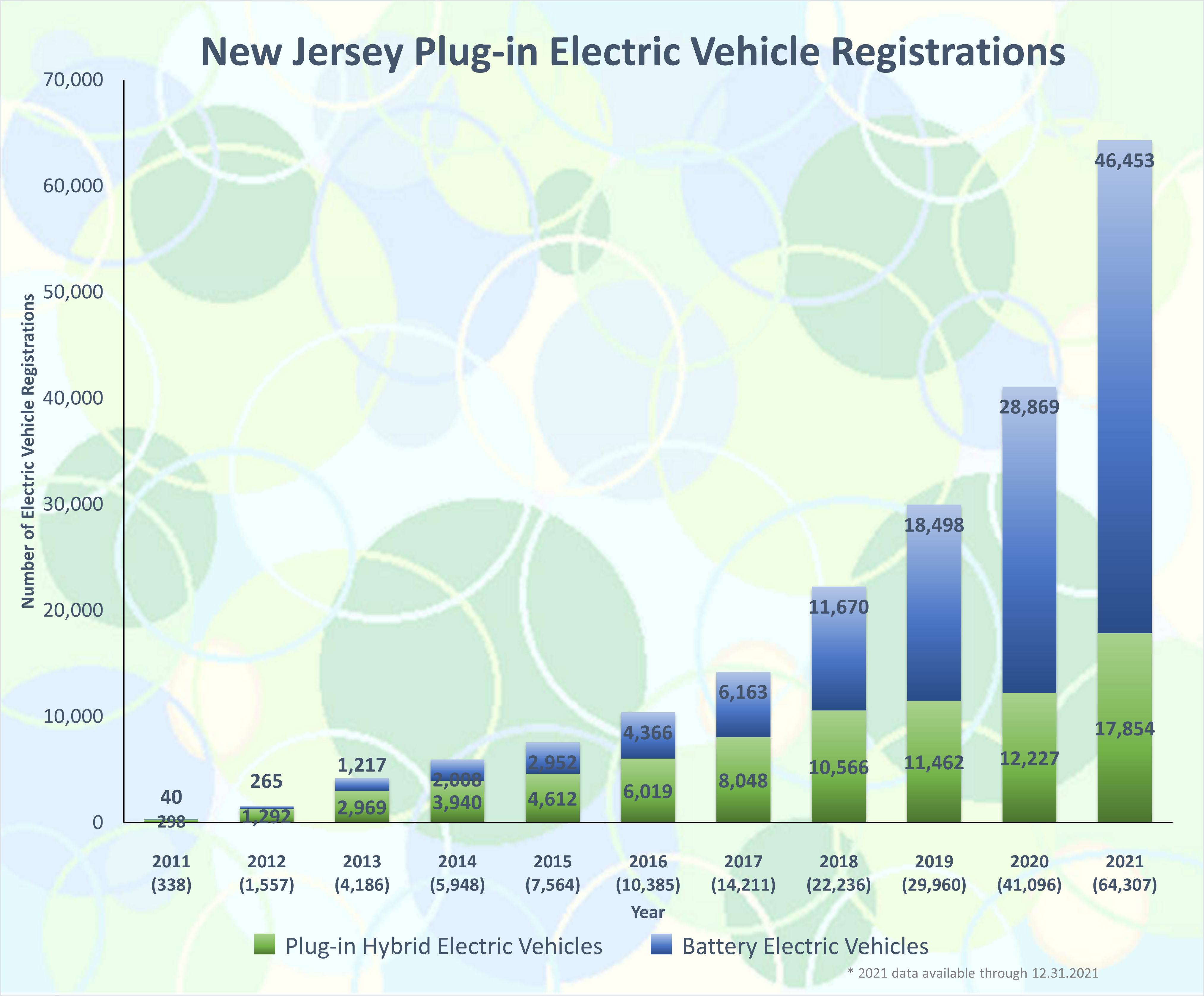
Having the highest number of registered electric cars on the road per public charging station of any state in the country, at a ratio of 46.16 (2), New Jersey stands to benefit greatly from NEVI’s formula funding for new EV charging stations. In total, NJDOT will receive $104.4 million from the program over five years (3). This sum represents 2.51 percent of the $4.2 billion that USDOT expects to provide to all states, Puerto Rico, and the District of Columbia through NEVI’s formula (3). For comparison, in 2020 New Jersey’s share of the total American population was roughly 2.8 percent (4), but critically, its share of land area is less than a fraction of a percent (5). Thus, in terms of EV charging infrastructure, the apportioned NEVI funding for New Jersey can ensure broader geographic coverage for its residents than may be possible for other less densely populated states.
Adoption of EV and Hybrid Electric Vehicles is growing exponentially in New Jersey as the technology and infrastructure continues to develop. Courtesy of NJ Department of Environmental Protection.
NEVI’s provisions mandate that interstates and highways designated as alternative fuel corridors (AFCs) must have charging stations at intervals of 50 miles or less (and within 1 mile from the highway itself (6)). In the most recent round of nominations, all of NJ’s interstate roadways were accepted and designated as AFCs by the FHWA, including: I-76, I-676, I-78, I-278, I-80, I-280, I-287, I-95, I-195, I-295, the Garden State Parkway, the New Jersey Turnpike, and the Atlantic City Expressway. At a minimum, the charging stations must have the capability to simultaneously charge four vehicles at 150kW each. The development of intercity EV infrastructure should expand the travel range and charging options for through-travelers and New Jerseyans who operate the State’s rapidly growing fleet of registered plug-in electric vehicles (PEVs) which numbered 64,307 in 2021 (7).
Far more charging stations will be required in New Jersey should the State achieve its goal of 100 percent PEV sales by 2035. By then, the EV vehicle fleet would reach 4.2 million registered EVs, or 73 percent of the estimated total of six million registered vehicles. The NJ EV Plan estimates that between 1,600 and 5,600 additional publicly available fast charging sites will be required throughout the state to meet these registration levels (1).
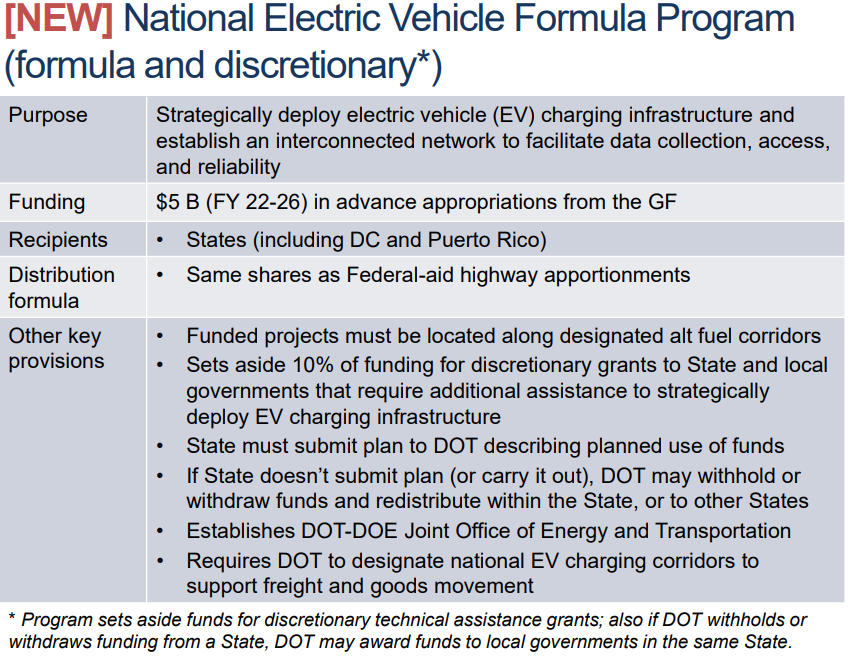
Beyond the $5 billion from NEVI, the program will establish the DOT-DOE Joint Office of Energy and Transportation to coordinate the shift in energy mixes for the nation’s transportation technology. Courtesy of the Federal Highway Administration.
Supplementing the NEVI Funding Formula program, the BiL sets aside discretionary funding through the National Electric Vehicle Infrastructure Competitive Program to fill in gaps in publicly accessible EV charging and hydrogen, propane, and natural gas fueling infrastructure along both designated alternative fuel corridors (50%) and in community locations (50%), such as parking facilities, public schools, public parks, or along public roads. Under this program, USDOT will prioritize projects that expand access to charging and alternative fueling infrastructure within rural areas, low- and moderate-income neighborhoods, and communities with limited parking space or a high ratio of multi-unit dwellings to single-family homes. Eligible entities include states, metropolitan planning organizations, local governments, political subdivisions, and tribal governments. NJ will be eligible to compete for these funds.
The NJ EV Plan establishes three phases for EV infrastructure development:
- Phase 1 focuses on developing electric vehicle supply equipment (EVSE) along the State’s AFCs toward achieving “fully built out” status pursuant to the national NEVI program guidance. Nominated corridors must be equipped with at least four, 150 kW chargers at least every 50 miles and located less than or equal to one mile from the corridor exit.
- Phase 2 focuses on addressing DC fast chargers on New Jersey’s main corridors every 25 miles, as established by State law and recognizing NJ as the most densely populated state. The State will incentivize the siting of charging stations at corridor interchanges to achieve the goal of EVSE chargers at a spacing of 25 and 50 miles. The 25-mile spacing provides opportunities to install one EVSE location at the intersection of two corridors and potentially serve both corridors which in some instances may save on installation costs.
- Phase 3 implements EVSE flexibly in accordance with community needs which could include community-centric charging as well as fast charging hubs near multi-unit dwellings (MUD) and in disadvantaged and overburdened communities to enable electric ride sharing and ride hailing.
The NJ EV Plan emphasizes that each phase will involve planning, community outreach, stakeholder engagement and alignment with Justice40 initiatives. While initial focus will be on Phase 1, the Plan allows for all phases to progress over the next five years (1).
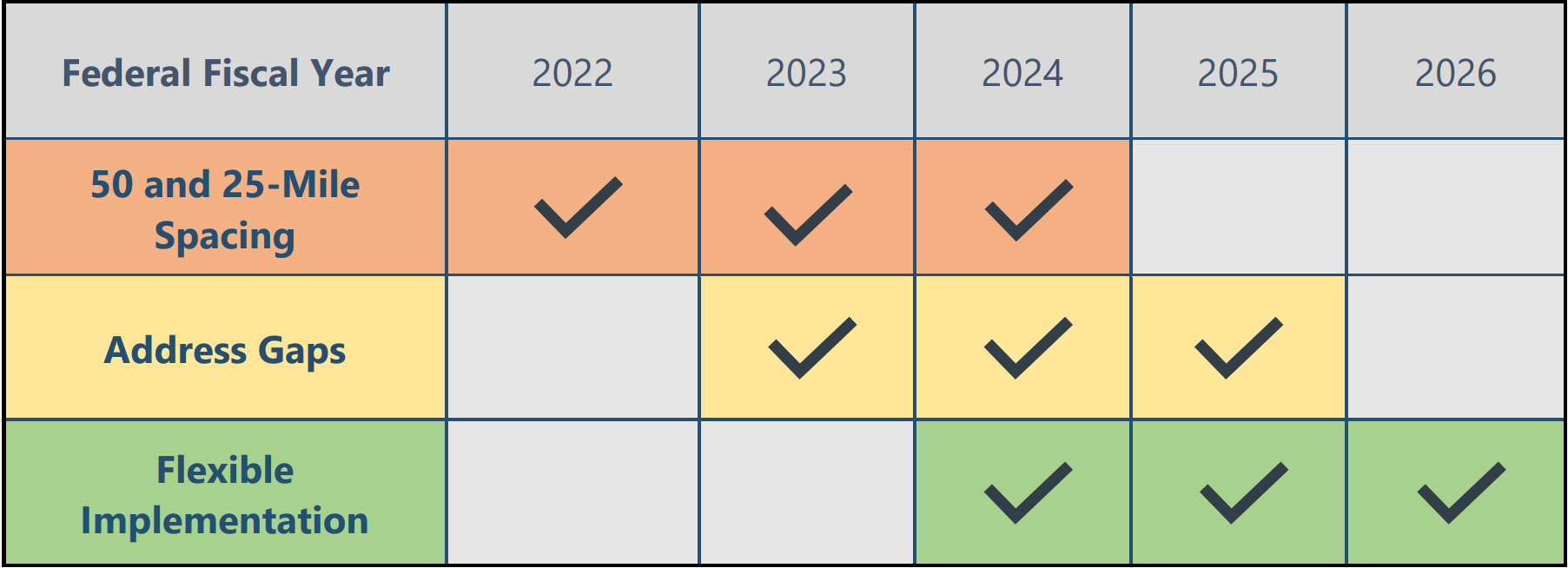
NJ EV Deployment Plan is divided into three overlapping phases over the five-year plan: Deployment of chargers between 50 and 25-mile spaces, addressing gaps in the network, and flexible implementation based on community needs. Courtesy of the New Jersey Department of Environmental Protection.
The NJ EV Deployment Plan notes the establishment of its “Partnership to Plug In,” a multi-agency partnership formed to coordinate the broader statewide rollout of EVs. Partnership to Plug In is co-led by NJBPU, NJDEP and NJEDA and “bolstered by support from Treasury, NJ TRANSIT and NJDOT” (1). NEVI formula funding will increase the support NJDOT can provide to the Partnership. The deployment plan frames NEVI as a stepping-stone towards NJ’s policy goals “of achieving 100% clean energy by 2050 and reducing State greenhouse gas emissions 80% below 2006 levels by 2050” (1).
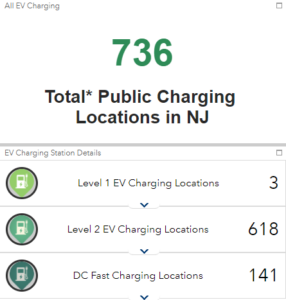
The expansion of NJ’s EV infrastructure network is a complementary next step to the state’s tax incentives and rebate programs and model municipal ordinance initiative to encourage greater EV adoption. Given a $173,000 cost estimate per station, New Jersey’s share of NEVI funding alone is expected to provide enough for 600 charging stations (9). For comparison, the NJDEP estimates roughly 736 Public Charging Locations in NJ (10), illustrating the scale of the potential impact from formula funding.
Looking to place charging stations at a maximum 25 miles apart in applicable routes, twice the frequency required by NEVI, recent NJ state law signals its goal to remain a leading state for owning or operating an electric car (11). As established in the BiL, the State of New Jersey will share 20 percent of NEVI costs (8). The State government has already committed to requiring that 100 percent of state-owned, non-emergency light-duty vehicles be EVs by 2035 (12) and requiring at least 400 DC Fast Charger public stations by the end of 2025 (12).
The composition of public charging locations in New Jersey would benefit if NEVI provides more DC Fast Charging stations, as the majority of NJ locations only provide lesser voltage Level 1 and 2 chargers. Courtesy of the New Jersey Department of Environmental Protection.
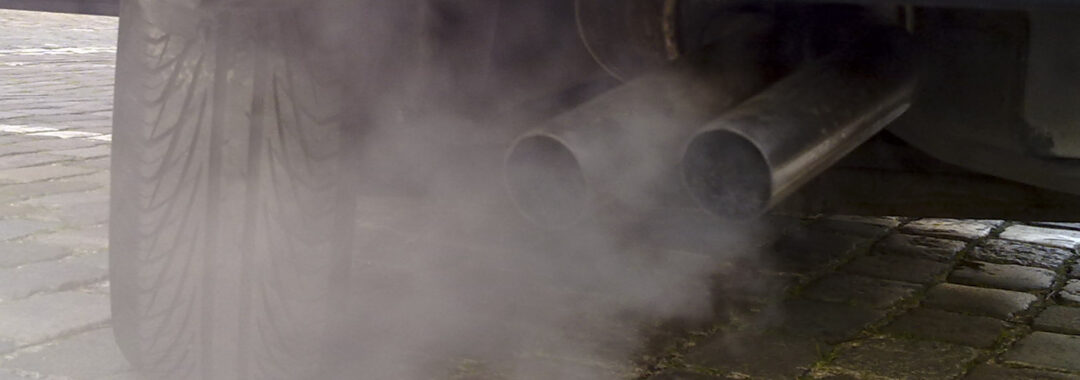
Gasoline exhaust from personal and commercial vehicles can lead to areas closer to highways experiencing disproportionate exposure to harmful air pollutants. Courtesy of Ruben de Rijcke, Wikimedia Commons
Equity in Environment, Workforce, Mobility and Community Economic Development Considerations
Creating the charging infrastructure to ease the transition from fossil fuels to electric vehicles is a rational response to the global climate crisis. It is also an opportunity to advance equity and environmental justice through transportation investments. Subject to the Biden administration’s Justice40 commitment to spend 40 percent of overall benefits of federal investments in climate and clean energy in disadvantaged communities (13), NEVI mandates placement of EV charging stations in the State’s affected disadvantaged communities to reduce the negative impacts of gasoline-based air pollutants.
The NJ EV Deployment Plan highlights the ways in which it is aligned with advancing the Justice40 commitment. The Plan outlines the State’s existing laws, regulations, guidance, mapping tools and outreach processes that it has employed, and expects to continue to employ, to deliver equitable transportation benefits and combat the health stressors borne by individuals living near highways and facilities from exposure to tail-pipe exhaust from conventional fuels. The Plan highlights equity, workforce development, mobility needs, and community benefit commitments and considerations. Emphasis is placed on continuing outreach and dialogue processes, through successive deployment phases, working with community leaders and labor organizations, chambers of commerce, community colleges, technical schools, universities, training organizations, and industry to ensure that the deployment, installation, operation, and use of EV charging infrastructure achieves equitable and fair distribution of benefits and services.
Deploying Transformative Public Investment to Meet a Global, National and State Challenge
The Federal-Aid Highway Act of 1956 serves as a reminder of the transformative impact of large-scale federal public infrastructure investment. The bill created a 41,000-mile “National System of Interstate and Defense” which accelerated the nation’s reliance on the personal automobile and commercial trucks for goods movement distribution and profoundly shaped our patterns of living today. Today our challenge is no longer building out the interstate system, but rather retrofitting our roadway systems and land use design to ensure a sufficient supply of EV charging stations. For this era, the aspirational vision for the NEVI program is to build a clean transportation network capable of ensuring reliable regional travel and supportive of carbon emission reduction goals to mitigate climate change impacts.
With its reported national budget of $5 billion (8), the NEVI program makes a critical national investment toward a future where the nation’s EV drivers will increasingly have the confidence to drive down any interstate, knowing charging stations will be waiting for them; non-EV drivers will likewise have fewer “range anxiety” concerns should this be a limiting factor in making the transition to operating a plug-in electric vehicle.
The NEVI program’s support will help keep the State’s economy and transportation competitive by complementing its advancements and goals in the EV market. Rewarding New Jersey’s innovation and commitments in encouraging the adoption of new EVs on its road, NEVI’s role in building out charging stations to service EVs will ultimately serve the State well. Increasing the reliability of New Jersey EV network will result in reductions in diesel and carbon emissions from automobiles, thereby protecting the environment, health, and pocketbooks of New Jerseyans.
RESOURCES
(1) New Jersey Department of Environmental Protection (2022, August 1). New Jersey National Electrical Vehicle Infrastructure (NEVI) Deployment Plan. https://www.nj.gov/dep/drivegreen/pdf/nevi.pdf
(2) Vermont Biz. (2022, May 12). Vermont is the ninth most accessible state in America to charge an electric car. https://vermontbiz.com/news/2022/may/12/vermont-ninth-most-accessible-state-america-charge-electric-car.
(3) U.S. Federal Highway Administration, U.S. Department of Transportation. (2022, February 10). 5-year National Electric Vehicle Infrastructure Funding by State. https://www.fhwa.dot.gov/bipartisan-infrastructure-law/evs_5year_nevi_funding_by_state.cfm.
(4) Iowa State University. (2022). Decennial Census Population Counts for States. https://www.icip.iastate.edu/tables/population/census-states
(5) United States Census Bureau. (2021, December 16). State Area Measurements and Internal Point Coordinates. https://www.census.gov/geographies/reference-files/2010/geo/state-area.html.
(6) Foley and Lardner LLP. (2022, February 24). U.S. DOT Releases NEVI Formula Program Guidance, Giving Public and Private Stakeholders a Roadmap for EV Infrastructure Funding. https://www.foley.com/en/insights/publications/2022/02/us-dot-releases-nevi-formula-program-guidance
(7) New Jersey Department of Environmental Protection. (2022). Drive Green Electric Vehicles Basics. https://nj.gov/dep/drivegreen/dg-electric-vehicles-basics.html
(8) U.S. Federal Highway Administration, U.S. Department of Transportation. (2022, February 10). National Electric Vehicle Infrastructure Formula Program. https://www.fhwa.dot.gov/bipartisan-infrastructure-law/nevi_formula_program.cfm.
(9) NJ.com. (2022, February 11). Feds sending $15M to N.J. to build electric car charging stations. https://www.nj.com/politics/2022/02/feds-sending-15m-to-nj-to-build-electric-car-charging-stations.html.
(10) New Jersey Department of Environmental Protection. (2022). NJ Public Electric Vehicle (EV) Charging Locator. https://njdep.maps.arcgis.com/apps/webappviewer/index.html?id=e41aa50dd8cd45faba8641b6be6097b1.
(11) Quartz. (2022, May 14). If you want to buy an EV, New Jersey is the place to be. https://qz.com/2165644/the-cheapest-states-in-the-us-to-buy-an-ev/.
(12) Alternative Fuels Data Center, U.S. Department of Energy. (2022). New Jersey Laws and Incentives. https://afdc.energy.gov/laws/all?state=NJ.
(13) U.S. Department of Transportation. (2022, July 8). Justice40 Initiative. https://www.transportation.gov/equity-Justice40.

